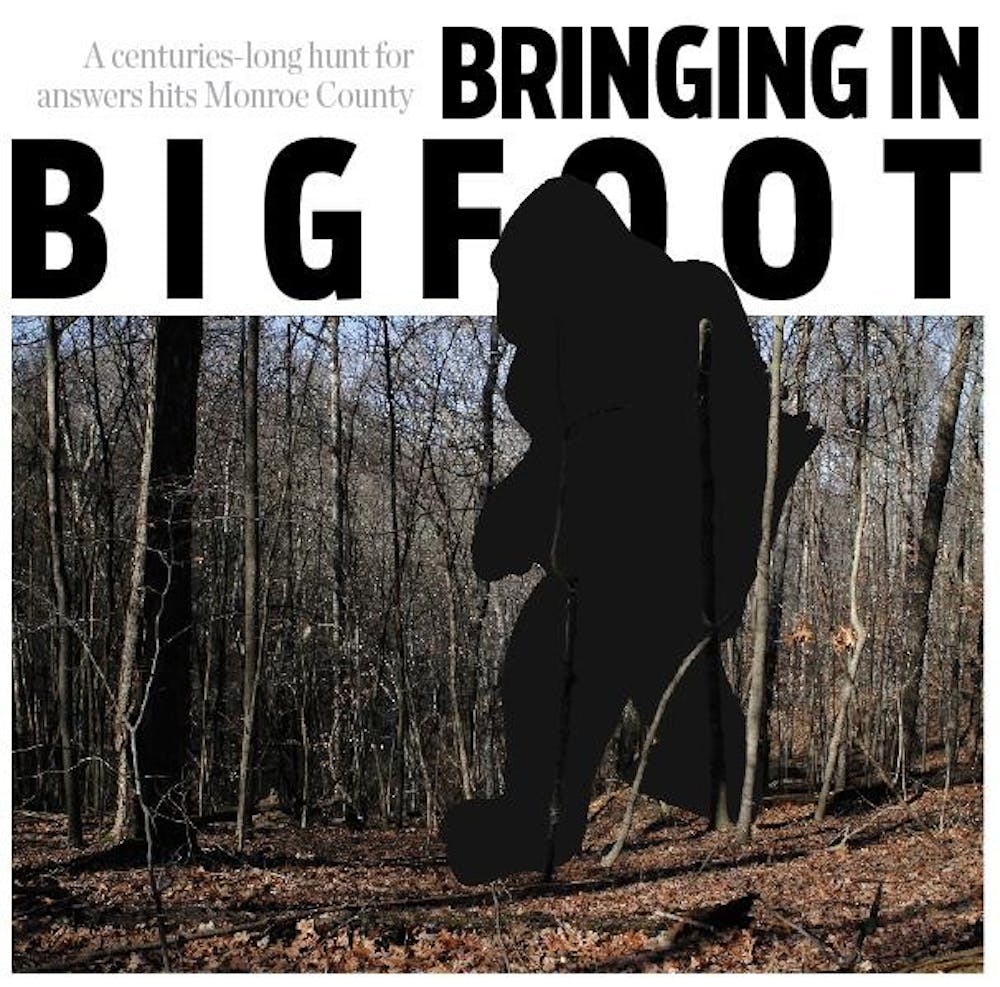Much of Southern Indiana is covered with woods. It’s not uncommon to see forest wildlife here, such as squirrels, opossums or deer.
But some believe these woods are home to a much larger creature: Bigfoot.
Last fall, a string of recent sightings sparked a visitation from the Animal Planet reality show “Finding Bigfoot.”
Mike Bardsley is the owner of the Indiana Bigfoot Awareness website and said he has had several encounters with Bigfoot in Kosciusko County in the northern half of the state.
“At fist, I was only really interested in finding out who else, where else and when other people in this immediate area might have had a sighting or encounter, after my middle child and a couple of friends had two different sightings take place ... in the fall of 2003,” Bardlsey said via email. “I’ve been pretty much around the whole state, as there have been reports from the north state line to the Ohio River. Many go back decades.”
Bardlsey said he has only had one visual sighting personally, back in 2009 during Fourth of July weekend, while at a research site with members of his group.
He left the campsite in his car early in the morning after recording 28 vocalizations for about two hours. While driving, he began to pull to the side of the road but then decided not to and continued. However, as he came back onto the road, he saw
something.
“Thinking it was another deer like I had just missed over on another road, I backed off the gas at about 20 mph and went to high beams,” Bardsley said. “That’s when I realized I was looking at a large, hair-covered black creature who began running off the road to the south.”
He said it was approximately 6.5 feet tall but might have been as tall as 7 feet.
“It was a very profound moment to see one after talking to quite a few people over the course of investigating the phenomenon who had told me about their encounters,” he said.
Bigfoot is not a new legend. Stories of Bigfoot with several different names date back thousands of years, since the beginning of man, said Rhettman Mullis, an academic and field researcher for Bigfootology.
Bigfootology is a nonprofit organization dedicated to using a multidisciplinary approach to make sense of Bigfoot.
The members also operate with the assumption that Bigfoot exists, which changes how they interpret the data. They know he exists; they’re just trying to figure out what kind of species they’re dealing with.
“We have artifacts going back thousands of years,” Mullis said. “In every Indian tribe around the world, Bigfoot goes by different names. Each Indian tribe has its own specific name.”
These names can include Sasquatch, Yowie, Meh-Teh and Mountain Man, among others.
“I actually have a hypothesis that a lot of our lore that we talk about these days is actually Bigfoot related,” Mullis said. “We have the boogeyman, we have the wildman, we have the ghouls in the woods. In England, we have the enchanted forests that would speak. Well, that’s all typical Bigfoot behavior. You go out into the woods, and you think you hear people talk. Well, you’re not psychotic. You’re probably hearing a few Bigfoot talk.”
One of the main goals of Bigfootology is to create a species profile for Bigfoot. Mullis said many members of their group believe Bigfoot build nests, live in family groups, are approximately 7 feet tall, are covered in hair and are omnivorous.
Mullis is also spearheading the idea that Bigfoot are diurnal, or active during the day, rather than nocturnal.
“Most incidents happen during the day,” Mullis said. “They build refuges away from men. So if they’re truly nocturnal, that means they’re sleeping during the day. That means, since we don’t go to their nests, how could we be seeing them?”
Mullis said based on the topography and forestation in southern Indiana, it would make sense for Bigfoot to live here, and Bardlsey agreed.
“Based on the number and consistency of reports coming out of the southern portions of the state, and meeting and talking with many who have had first-hand, personal experiences, I just have to believe that grown, rational people can be telling the truth about what’s happened to them,” Bardsley said in the email.
One common misconception with Bigfoot is that he is a monster. Mullis said the vast majority of reports involving Bigfoot are non-confrontational.
However, Bigfoot is an animal like any other, and therefore, when cornered or threatened, he could respond violently.
“Most people don’t want to talk about the horror stories because we don’t want people to get the wrong impression,” Mullis said. “Most horror stories actually happen with women. There’s a significant history of kidnapping, rape. As a matter of fact, that’s the most common story amongst every tribe, especially in North America. They’ll have women that will be taken and they will be bred with.”
Mullis also pointed out there are several stories of Bigfoot helping humans as well, including rescuing children and injured hikers.
“There’s stories about good and bad,” Mullis said. “So I tell people to be careful, because they’re just an animal like everybody else.”
Bardlsey said he’s been convinced of Bigfoot’s existence through his own experiences and believes one day we will inevitably find Bigfoot to exist, but perhaps we aren’t ready yet.
“I’m hoping for now, until we know more about them, they’ll remain hidden from humankind,” Bardsley said. “We don’t have the greatest track record of dealing with things we don’t really understand.”
Bringing in Bigfoot: A centuries-long hunt for answers hits Monroe County

Get stories like this in your inbox
Subscribe





